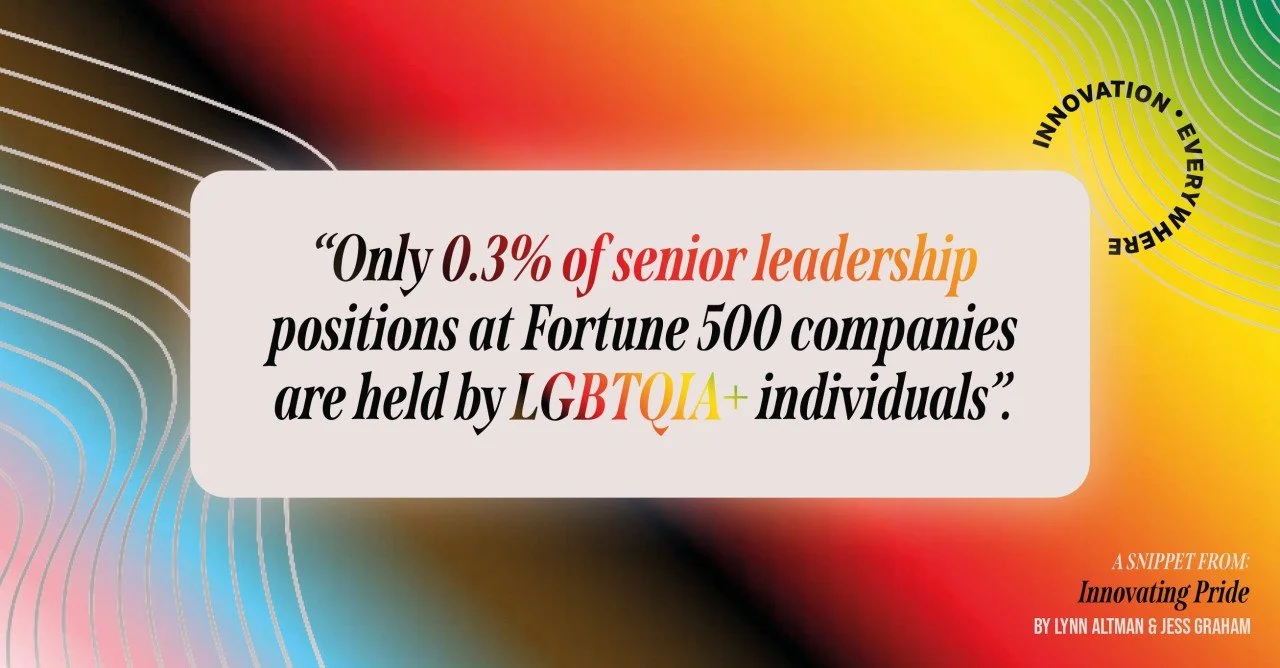Innovating Pride
Pride Month has almost come to a close, and once again the rituals remain: brands have added flags, rainbows, and messages of support to their labels and clothing; anti-LBGTQIA+ bullies have threatened Target store employees; and no “All-American” brand has dared to bring on another transgender spokesperson.
It makes me think: Are we actually doing Pride Month right? Or more succinctly: Is there a way to do it better? And even still: As someone who has always been in heterosexual relationships, am I the right person to be asking this question?
To help me dig into this question, I reached out to friend, colleague, marketing strategist and fierce advocate for equity, Jess Graham . We discussed the history of Pride, how Pride month functions differently than other community-themed months, and where opportunities for innovation may lie.
Quick Win: The Name
I will admit that, more than once, I have stumbled over the alphabet soup LGBTQIA+ acronym, and I’m sure I’m not alone. Jess uses the term “Queer” because, in addition to being easier to say, it is all-encompassing and very inclusive—which is ultimately what the intention of the acronym is in the first place. I will be using this terminology throughout the rest of this piece, with this in mind.
Question #1: Are we doing Pride month right?
Writer José Criales-Unzueta points out in Vogue Business that, during the month of June, “Pride merch has evolved from small displays of allyship, often tied to charity, to a rainbow explosion without a clear reason for existing — that sometimes goes too far.”
Even more so, the merchandise and brand promotions don’t relate to anything that actually benefits the queer community. And once July 1st hits, we’re done with rainbow flags and back to American ones with fireworks ablaze in the background.
Brands tout their advocacy for the community, without actually doing anything to support them. And they are sorely behind when it comes to actual representation in advertising and media throughout the rest of the year. A study by GLAAD and Kantar called the “Advertising Visibility Index” found that “only 3% of the 2022 ads on national linear television from the top ten largest advertisers included LGBTQ people.”
But it gets worse. According to a 2021 study conducted at the Medical University of South Carolina, only .3% of senior leadership positions at Fortune 500 companies are held by LGBTQIA+ individuals.
Question #2: Is there a way to do it better?
Looking at the figures above, the answer becomes clear. While celebrating a community and Pride is so very important, there are ways that companies and brands could really move the needle:
Put your money where your mantra is If you tout Pride, have Pride-related promotions, packaging, or merch—make sure that a real percentage of profits are going to actually support the communities you’re highlighting.
Love your Queer consumers Brands know that representing their consumers in advertising and media is a way to make a deep connection with them. Including members from the Queer community on a regular, consistent, ongoing basis would demonstrate a true commitment to Pride.
Pride starts from within Leaders like Apple CEO Tim Cook and Macy’s CEO Jeff Gennette have paved the way for visibly Queer leaders in business. But companies still have a long way to go, especially when it comes to assigning women, transgender leaders, and Queer people of color to the highest roles in the company. Without this representation at the top, true and authentic advocacy can never be reached.
Question #3: Am I the right person to ask this question?
In my conversation with Jess, this was the first topic I covered, because it’s important to me to understand what my role as an Ally is—and where it might overstep boundaries and fall into my own Pride trap, as it were. Jess assured me that the best way of entering a discussion as an outsider was to ask questions, and if we don’t feel like we have the right to ask questions, then we’re never going to get anywhere.
More poignantly, she reminded me that we’re all part of the same community. We all have Queer friends, neighbors, partners, kids. Pride month isn’t just for her, it’s for all of us.
And with that spirit, we can surely do a whole lot better.

